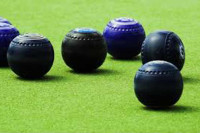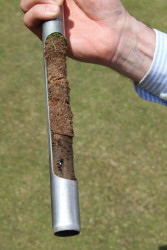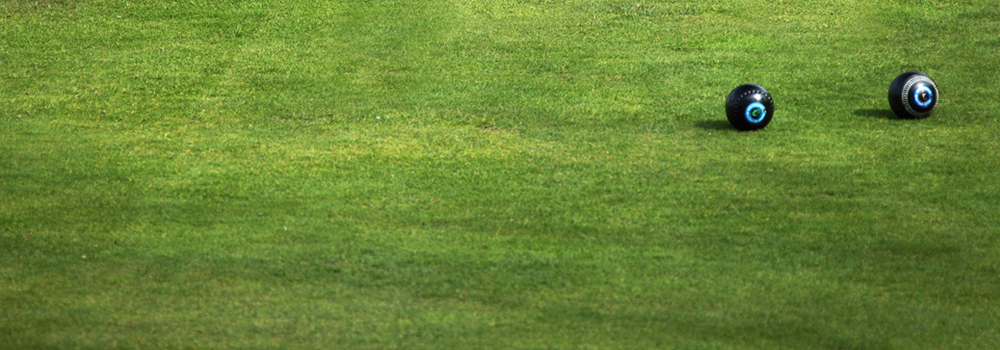
Priority work for the start of March is to aerate the green to help gaseous exchanges and increase water infiltration through the soil profile; an application of iron sulphate will help improve colour and kill any moss that has established during the winter months, some clubs apply a lawn sand to kill the moss.
You will need to ensure your mowers are ready for the start of the season, serviced, sharpened and ready to go. Check your height of cut, you do not want to be cutting too low; some clubs may even use pedestrian rotaries to help clean up the green and carry out their initial cuts.
Ensure you brush the dew off the green before cutting, this helps reduce the amount of water on the leaf blade, a dry leaf cuts better than a wet one. This can be done by dragging a hose pipe, a dragmat or dragbrush or a switching cane.
Key Tasks for March

- Roll the greens
- Daily brushing and switching of greens
- Worm control. It may be necessary to apply an approved carbendazim based product to control worm activity.
Mowing. Weekly or as required. Soil and air temperatures will begin to rise in March and this will stimulate grass growth. Begin cutting when weather conditions allow. Regular mowing will now be implemented to develop an even sward and to keep the surface uniform. It is important to lower the height of cut gradually until reaching the optimum height for match play at the start of the bowling season.
Keep at 10-12mm at the start of the month and gradually reducing to 8mm by the end of the month.
Aeration: When conditions allow. Do not carry out aeration when there is the likelihood of smearing or damaging the surface. Aeration is important to improve surface and subsurface drainage of the green.
Scarifying: Pre-season scarifying should be carried out to remove moss, thatch and decaying matter that may have formed during the winter.
Fertilising: Ideally, you should have conducted a soil analysis of your soil profile to ascertain the nutrient status of your green. This will help you decide on what fertiliser products to buy and apply. Ensure you apply at the recommended rates and do not overdose the green or overlap when applying the products. There are plenty of spring fertiliser products available to meet your needs.




Closely monitoring soil temperatures with a digital soil thermometer is the preserve of the informed and agronomically focused individual as we enter into March. Soil biology and plant function depends on temperatures which encourage metabolic function – there is a reason your refrigerator is set to 5 °C. The minimum temperature whereby things will start to get going on a sustained basis is 8°C. Anything above 10-12°C is the point whereby good noticeable responses will take place.
One of the key points of understanding with regard to this principle is that day time temperatures are not the factor which drives an increasing base line with regard to soil temperatures. Night time temperatures are the key factor which will either hold the base line underneath the 8°C threshold or assist in pushing it over the bar into good growth response.
Understanding how the soil temperature is fluctuating, by taking and noting daily soil temperature readings (ideally at the same time of day), will provide you with insight into when you should actually be timing operations.
It can be all too tempting to apply fertiliser, stimulants, plant protection products, or undertake operations such as scarification, aeration, top dressing and seed sowing based on what the calendar says as opposed to what the data says. The key message here is that nature will run at nature’s pace, and when we strive to undertake operations to push things forward we can inadvertently result in placing stressed surfaces under more stress, which will hold back positive gains when everything does start to kick into gear. Not to mention money can potentially be wasted by applying products the soil and plant cannot utilise.
In terms of inputs; if weather conditions are cool, but surfaces are looking stressed, a light application of foliar fertiliser mixed with a good quality liquid humate product containing fulvic acid will aid uptake efficiency and response. Mixing in some calcium and chelated iron will toughen the leaf cells and guard the plant against stress. If soil temperatures are warmer and activity is increased, then a granular fertiliser containing a reasonable dose of sulphur will help to kick plant function into action.
Feeding soil biology with a carbon source, such as sugars and humates, will help to support the soil plant ecosystem crucial to plant health. Seaweed feeds are also vital in terms of assisting soil biology and priming plants’ natural defences.
Seed can be applied to any bare areas which may remain from autumn renovations, but establishment will benefit from it being pre-germinated (chitted) and, if appropriate, for your surface to be protected by a germination sheet.
Keep an eye out for warm temperatures coinciding with damp still days for more than 24 hours continually, as this will represent high risk for outbreaks of microdochium nivale. Applications of systemic fungicides during warmer spells will provide preventative protection. Removal of dews and minimising periods of continued leaf blade wetness is an essential cultural method of preventing disease.
Plant strengthening tank mixes of calcium, phosphite and chelated iron, facilitated with a humate adjuvant, will strengthen plant cell walls and natural defences. Managing plant vulnerability by understanding and using nutritional inputs can be done in isolation or alongside fungicide programmes.
One thing that everyone should bear in mind is that an integrated approach to the management of turf pathogens, utilising a multifaceted approach, is the future of the industry. Greater legislative pressure will place an increasing demand on many of the traditional chemical options. Individuals involved in maintaining turf surfaces at any level of the industry will be well served to be seeking out knowledge which will allow them to integrate alternative methods and programmes of maintenance into their surfaces now, in a proactive manner ahead of the inevitable changes. Changes which, if not planned for, will initiate a reactive approach from a weak position of understanding.
Particle Size Distribution (PSD). March is a good time to take soil samples and get them sent off for analysis, enabling you to get them back in time to start your new year's maintenance. Ideally, if you have not had one done before, you should have a full (PSD) Particle Size Distribution soil analysis done to tell you the actual make up of your soil profile.
Soil is made up of percentages of clay, silt and sand. The PSD analysis will identify the ratio of these and confirm soil type, thus giving you a better understanding of what soil you are dealing with.
Soil pH. Also, you can establish the amount of organic matter (OM) content, as well as soil nutrient status and soil pH. With this information, you will be able to identify the needs of your soil.
Carrying out these test also allows you to check other physical conditions of the green, such as root depth, levels of compaction and aerobic state of the soil.
Some clubs continue to apply wetting agents to help improve and enhance soil performance. A wetting agent is such a substance that reduces the surface tension of a liquid, causing the liquid to spread across or penetrate the soil profile more easily. These are usually applied on a monthly basis.
N:P:K: Keeping a balance of N P K nutrients within the soil profile is essential for healthy plant growth.

Keep an eye on fungal disease attack and use approved fungicides to treat infected areas. The typical types of diseases you may come across are:
- Fusarium Patch
- Red Thread
- Fairy Rings
- Anthracnose
Use appropriate fungicides to control any further outbreaks, however, with the grass beginning to grow, it won't take long for these scars to grow out.
Please note: More information on these and many others can be found here: https://www.pitchcare.com/useful/diseases.php

Keep all machines overhauled and clean.
Inspect and repair any watering or irrigation systems; many bowling clubs now have pop-up irrigation systems. Organise an inspection, re-commissioning and calibration of the system.

Now you can learn about maintaining a bowls green in the comfort of your own home and in your own time. This newly developed course consists of a number of videos with assessment questions, and an accompanying hard copy Course Manual. The Online Course is Lantra accredited and provides you with all the basic knowledge required to maintain a green over a 12 month period. There is also the option of attending a one day practical course.
Pitchcare is the only provider of LANTRA accredited training courses in the maintenance of Bowls Greens.
We can also arrange Lantra accredited training on site to groups of 6 – 10 people. Email Chris Johnson for information.
Have a look at the new Grounds Training Website
- Check and service floodlighting systems; ensuring they are ready for the new playing season.
- It also important to replace any worn tines on your aeration equipment.
- Clean out the shed, sell off any old machinery and dispose of any junk that’s clogging up the shed.


